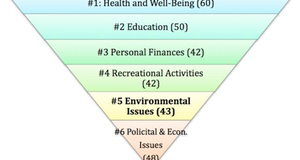From Earth Common Journal VOL. 3 NO. 1Soaring to Green Heights: The Current Sustainable Initiatives in the Commercial Airline Industry
IN THIS ARTICLE
KEYWORDS
AbstractThe air travel industry is changing. The needs of the environment are being considered and research into ways of improving the industry is being explored. This paper explores the current climate in the commercial airline industry, paying special attention to the ways in which Boeing and Airbus are ensuring the developments of greener technologies. Included is an examination of a diverse range of the research and literature available on the aviation industry and the impacts it poses on the environment in its current state. With that, the question of corporate social responsibility is acknowledged along with a deeper look into the sustainable practices in the industry. Additionally, the paper compares the Boeing 787 Dreamliner to the Airbus A380, two of the most eco-friendly commercial wide-body aircrafts on the market. Ways in which the industry utilizes the PRME principles are also mentioned. IntroductionAs time progresses, our desire to remain connected is ever increasing. Because of this, technology must evolve in order to continue fulfilling our travel need but the increasing demand to remain connected. Communication and transportation technologies have seen drastic changes in recent years and these advancements can be attributed largely to globalization. Globalization has revolutionized the ways in which contemporary society interacts (Chen, 2012, p. 65). Our ability to travel around the world has reached new heights and the commercial airline industry has made it possible for people to connect and interact face to face in a matter of hours. Travel, both domestic and international, is extremely efficient and accessible in contemporary society; however, the impact that the commercial airline industry poses on the environment is significant (Cowper-Smith & de Grosbois, 2011, p. 59). While the industry has acknowledged the dire environmental repercussions that could be felt if aviation technology remains stagnant, there are many initiatives that are being taken by aircraft manufacturers, airlines, and government bodies to ensure the evolution of a more sustainable industry with room for future growth and prosperity. Greenhouse gas emissions are the topic of concern in relation to air travel; however, the air industry is only responsible for three to five percent of emissions (Cowper-Smith & de Grosbois, 2011, p. 61), compared to the transportation sector, as a whole, being responsible for 20% of emissions (Greener Planes, 2008, para. 6). It should be noted that the air industry is responsible for eight percent of global economic activity (Greener Planes, 2008, para. 6) and, therefore, plays an integral role in the world economy. While this is significant, one must not negate the industry’s imposition on the environment – it is important to further investigate the industry as a whole and examine what methods are being used to combat the issues that surround its environmental footprint. The steps that go into the engineering and development of contemporary aircrafts must exude sustainability and conscious environmental awareness. The question of corporate social responsibility (CSR) is asked. The nature of the airline industry possesses massive influence and this topic will be explored further. The industry is not blind to the threat that it poses on the environment; however, as consumers, it is necessary to acknowledge and understand the degree to which the industry is evolving and changing for the better. Two of the biggest commercial aircraft manufacturers, Boeing and Airbus, have implemented a number of environmental initiatives and are developing greener technologies with which to fly their airplanes. Because of this, it is necessary to examine these developments further and analyze their environmental initiatives. Air travel is unavoidable. To completely do away with the industry is unfathomable and unrealistic in the 21st century. It provides many conveniences with which contemporary society could not function; instead, one must acknowledge the initiatives that are being implemented by aircraft manufacturers and, subsequently, by airlines. Review of the LiteratureLiterature on the greening of the commercial airline industry is not sparse. There are a variety of sources that touch on the methods being used to create a more sustainable industry. These sources largely examine the industry with scrutiny but are favorable in their recognition of the changes that manufacturers and airlines are implementing. Periodical articles, academic articles, environmental reports, and sustainability and environmental plans are consulted for a thorough understanding of the topic at large. With an ever-evolving industry, it is necessary to stay current on the technological changes. To understand the current climate relating to the airline industry from an academic perspective, the scholarly article “The adoption of corporate social responsibility practices in the airline industry” (2011) examines the degree to which the industry is adapting sustainable practices. What was once a “one-page declaration of commitment to the environment and society [is being] replaced by more comprehensive reports providing detailed information on specific initiatives and their results” (Cowper-Smith & de Grosboi, 2011, p. 60). This article, focusing on CSR in the airline industry, discusses the exploration into the industry’s current state of environmental affairs. This source is very focused on the CSR of airlines and how, and if, it is being carried out. There are some useful insights into the current state of the industry and its attitudes toward environmentalism. In another respect, the article “Greener planes — but lots more of them: Aviation industry flies in face of environment concerns” (2008), focuses on the advancements that the airline industry has seen. The author compares the stance of both the environmentalists and the airline industry, outlining that the environmentalists are not aware of the extraordinary advancements that the manufacturers are making while the manufacturers are disregarding what the environmentalists are saying as quackery and a lack of knowledge (para. 5). Additionally, the environmentalists “demand a reduction in the people’s use of air transport as key to solving the climate change threats;” however, the industry would not be willing to see a conscious decline in ridership (para. 9). The author heavily acknowledges the advancements made by Boeing and Airbus, which will be consulted later on. The article “The Eco-Friendly Skies” (2008) dives into the potentially disastrous results that could plague the environment if changes are not made; however, a detailed explanation of the current steps being taken to sustainability are discussed. The article discusses the industry’s shift into the research of biofuels and how this would be beneficial in the long run (Gaffney, 2008, p. 43). As well, changing the ways in which the planes are actually flown to result in less fuel consumption and greater efficiency is explored (Gaffney, 2008, pp. 44-45). A shift in research from making faster planes to developing fuel-efficient aircrafts is a product of the twenty-first century, largely associated with an increase in fuel costs (Gaffney, 2008, p. 45). One cannot forget the global influence the airline industry has. In this same vein, Chen’s (2012) research focuses on Southeast Asia. Chen discusses the opinions held by those involved in the Taiwanese air industry in relation to environmental conservation. It is discovered that Taiwanese “airline managers mostly have a positive and supportive attitude towards environmental management” (Chen, 2012, p. 68). The question of CSR is, again, acknowledged and placed at the forefront in order to maintain a proactive and progressive public image. This study provides further insight into the largely accepted belief that environmentalism in the airline industry is necessary and must be further promoted and researched. As the airline industry is associated with travel, the National Geographic article, “Green Class,” written by Christ, explains the current climate of environmentalism in the airline industry in a leisure-focused manner. The article applauds air travel as a favorable industry; however, the skies are becoming more populous with planes, seeing an 11% spike in population from 2005 to 2010 (Christ, 2012, para. 4). It is fact that research into sustainable technologies is being performed, with Christ discussing the recent additions of the Boeing 787 Dreamliner and Airbus A380 aircrafts to airlines’ fleets. These planes, Christ describes, are a response to old and outdated aviation technologies and it is necessary for them to be replaced with these eco-friendly alternatives (2012, para. 4). The International Air Transport Association (IATA), is the body that represents a number of the world’s airlines and plays a key role in the creation and implementation of aviation policies (IATA, 2013a). The IATA is devoted to developing policies relating to environmental sustainability in the industry, promoting proper CSR, and necessary technological development (IATA, 2013b; IATA, 2013c). The airline industry is ever-evolving and changing. Because of this, it is necessary to be aware of the advances that the manufacturers are spearheading. While the industry received the brunt of negative press and allegations relating to the environment, one cannot discredit the industry leaders for their awareness of the industry’s impact. Research into prolonging the longevity of the industry and reducing its environmental impact is evident.Continued on Next Page » Suggested Reading from Inquiries Journal
Inquiries Journal provides undergraduate and graduate students around the world a platform for the wide dissemination of academic work over a range of core disciplines. Representing the work of students from hundreds of institutions around the globe, Inquiries Journal's large database of academic articles is completely free. Learn more | Blog | Submit Latest in Environmental Studies |

















